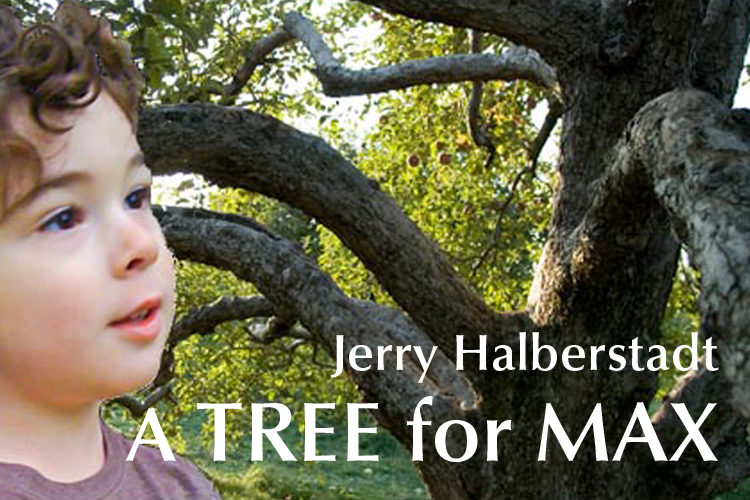We humans seem to become part of a landscape wherever we are planted, to wear it like a garment or a skin, to possess, and be possessed by the rocks and the trees of our places, and it is incredible to think that we cannot forever inhabit our land or our place.
My grandson, Max, was upset by moving to a new home. He focused all his feelings of loss and dislocation on the stand of trees in his old yard, and said, “I miss my forest.” This inspired the gift to him of a tree and the writing of A Tree for Max.
Max is like all of us who are rooted to a place. What if we were to move? Or die? Or if by some evil spell, the landscape itself should change. A hurricane, a blizzard, a flood, an earthquake, a tsunami, rebellion, war–all can devastate a place.
It is even harder to comprehend how our economics, reinforced by social and cultural customs, so well suited to earlier times, have created climate change and global warming which threaten to devastate the planet which is our home.
Trees are rooted in the earth, they do not move about. If we move, we must leave our trees behind. Can we survive without our trees? If the climate changes, the trees cannot move to a new place which has a suitable clime. Warmer winters will reduce or end the harvest of maple syrup. Apple trees need a certain number of days of cold. We humans have a hard enough time dealing with the changing seasons and have holidays and rituals to remind ourselves of the passage of time. How will we manage when the earth itself changes?
The New Year for the Trees, Rosh HaShana l’Elanot, is a Jewish festival timed to the ancient agricultural cycle of Israel. It is called Tu B’Shvat because it takes place on the 15th day of the month of Shvat. “Tu” stands for the letter Tet signifying “9” and Vav, “6”. In Israel, Tu B’Shvat falls after most of the winter rains, and at the beginning of warmer weather. Farmers need the earth to be moist so they can plant, and the warmer days cause the sap to flow. This year, Tu B’Shvat begins at sunset on February 8.
Jewish tradition forbids eating fruit from trees for three years after planting, and the fourth year crop was to be a tithe, so only in the fifth year could the farmer harvest and use the crop. (Leviticus 19:23-25) Experts today advise not to allow fruits to grow for 2-3 years after planting, in order to help the tree to develop.
When our family lived in Israel for over a decade, including a few months on a kibbutz, I was exposed to the agricultural seasons which were celebrated with national and religious holidays. We lived in the hills of Jerusalem, overlooking the Jordan Valley, and observed almond trees blossoming in the spring. The contrast with the bare, desert landscape was striking. The trees dotting the hillside were covered with flowers, and surrounded by perfume, we watched the bees visiting the flowers.
Moving to Israel was an adventure, not without stress. Leaving Israel was, for each of us, painful.
When I learned that Max was having issues with his move to a new home, I thought perhaps planting a tree would give him a new focus. Yet, I had no idea how deeply he and his parents felt the loss of their home, how deeply rooted they were in that place, with those trees, with those experiences. They still lament the richness of their lives among the trees.
What kind of a world will we leave for Max and all the children? If we refuse to recognize the threat of global warming, and are paralyzed from taking any action, we will not be able to prevent disaster. Yet experts claim that we have the science and technology that, if applied, could provide the world with clean energy, jobs, and preserve a home for mankind.
Not so long ago, our ancestors had devised rules for living together and for respecting the environment. They made and followed rules for growing fruit trees, including the wisdom of not taking too much from the tree at an early age, and the need to pay taxes to support communal functions. We seem to be ruled today by an ideology that endorses selfishness and seeks to take from the environment without counting the costs.
In A Tree for Max, Grandfather Apple Tree, the King of the trees, all the trees of the forest, birds, and a dog worked together to get Max a tree. Can we reach back into our traditions and derive some new rules for responsible action? Can we possibly find a way to work together to save the earth for the trees and for Max and all the children?
View pages from A Tree for Max
Original, longer version of this essay: Time, space, and trees that have birthdays
This post has been contributed by a third party. The opinions, facts and any media content are presented solely by the author, and JewishBoston assumes no responsibility for them. Want to add your voice to the conversation? Publish your own post here. MORE

